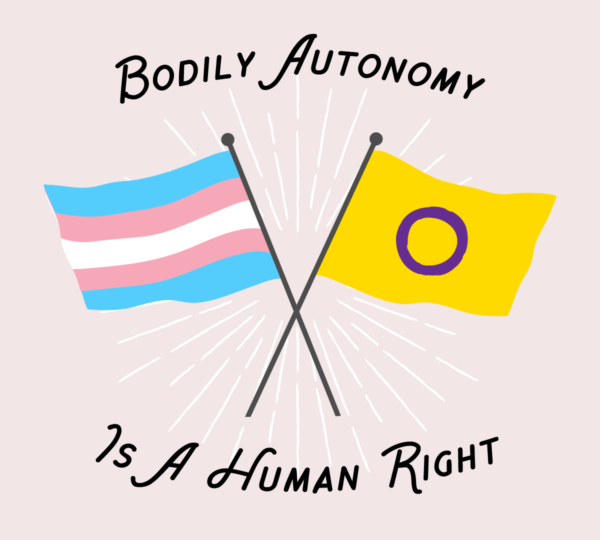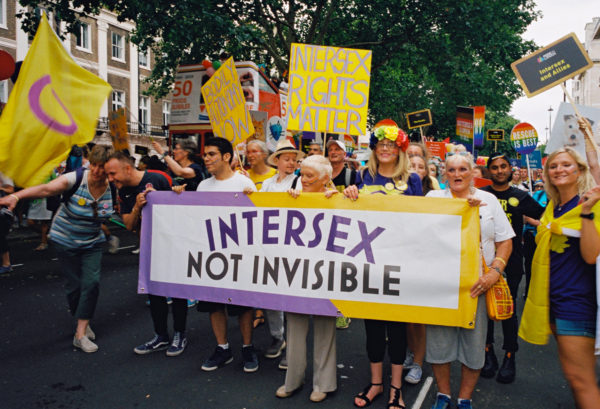FAQ: Intersex, Gender, and LGBTQIA+
Intersex people, like anyone, can have any gender and any sexual orientation. Some intersex people are also LGBTQA+, and others are not. General trends and attitudes about grouping intersex movements with LGBTQA+ movements will vary by country.
Last updated May 18th, 2020.
Jump to a question:
- What is the difference between intersex and transgender?
- Is intersex the same thing as nonbinary?
- Is intersex a gender?
- Should we include the “I” in LGBTQIA?
What is the difference between intersex and transgender?

An illustration of the transgender and intersex flags by Alex Yoon for Transgender Education Network of Texas
A transgender person has a gender that is different than what adults assumed by looking at their body when they were born. For example, a person born with a vulva and vagina may grow up to realize they are not a woman. They could grow up as a transgender man, nonbinary person, or someone with another gender. People realize they are transgender at many different ages. Some may later affirm their gender through physical and/or medical changes. Most transgender people are not born with differences in the development of their genitals or reproductive anatomy.
Intersex people are born with differences in their chromosomes, genitals, or reproductive anatomy, compared to the usual two ways that bodies develop. Most children with intersex anatomy, regardless of how their bodies look, are raised in either male or female gender roles. And many intersex people do grow up with a gender identity that aligns with how they were raised: male or female. This means that intersex people can be cisgender. (“Cisgender” means someone is the gender that was assumed for them at birth.)
Intersex people may also grow up to realize that the gender they were raised as was wrong for them. In this way, a person can be both intersex and transgender. interACT Youth member Mari spoke on the podcast Gender Reveal, to share their experience being both intersex and transgender.
Intersex and transgender people both challenge the common myth that gender is dependent on body parts. The two communities face many overlapping issues. Often, transgender people have to fight to access surgeries that they do want, while intersex people have to fight against surgeries that they don’t want—or already received as young children without their consent.
Is intersex the same thing as nonbinary?
Intersex is a word that describes a spectrum of physical traits—different ways that bodies can develop. Nonbinary usually describes a person’s experience with gender.
Gender is social, cultural, and personal. It affects how people dress, behave, and want others in the world to see them. Many people, including most intersex people, describe their gender using the words “male” or “female.” interACT generally avoids the words “male” and “female” when describing body parts, because not all people within a gender category will have the same body parts. Gender is not dependent on body parts.
People with all kinds of bodies have all kinds of genders. Nonbinary people might experience gender in a way that is not exactly male or female—maybe it’s neither, both, inbetween, or somewhere else completely. Nonbinary often gets grouped under the transgender umbrella.
Some intersex people may describe themselves as having “nonbinary bodies.” This refers to sex development being a spectrum, but it does not mean that all intersex people have nonbinary genders. Intersex people can be nonbinary, men, women, or might use other words to describe themselves. It is always best to ask individuals how they describe their body parts and gender identities.
Is intersex a gender?
It is uncommon for the word to be used that way. Intersex is usually an adjective that describes a person’s body. Their gender is something else. For example, there are intersex men, intersex women, intersex nonbinary people, and others. For many people, intersex traits strongly affect their relationship to their gender.
Using intersex or intergender as a personal label, without having an intersex experience, may be considered inappropriate.
Should we include the “I” in LGBTQIA?

Intersex advocates march in a LGBTQIA+ Pride parade in Europe.
Intersex people face very similar issues to LGBTQA+ people. Some, but not all, intersex people are also LGBTQA+. Intersex people are told they are “disordered,” just like gay and transgender people were told for decades.
Fear of gay and transgender people causes many of the problems that intersex people face. Where does that fear come from? As the artist Alok and the academic Kyla Schuller explain, the ideas that cause these fears—that there are two rigid and “opposite” sex categories with anatomy and gender roles that go with them—come from racism and eugenics movements in Europe and the United States.
Of course we are stronger when we fight the roots of these common problems together. Many advocacy organizations, including interACT, do regularly include the “I” in LGBTQIA. This is becoming much more common in the United States.
In some countries, any LGBT+ affiliation can be dangerous for intersex people whose differences are visible on their bodies. We always consider this carefully.
We recommend adding intersex to your organization’s LGBTQIA+ acronym only once you have intersex leadership, consultation and/or resources. Intersex people have very specific needs, just like each letter of the acronym.
Our #4intersex ally education toolkit can help. Also see this article on how queer people can be allies to intersex people.
Learned something new? Sign up for interACT’s quarterly emails to get even more intersex resources:
